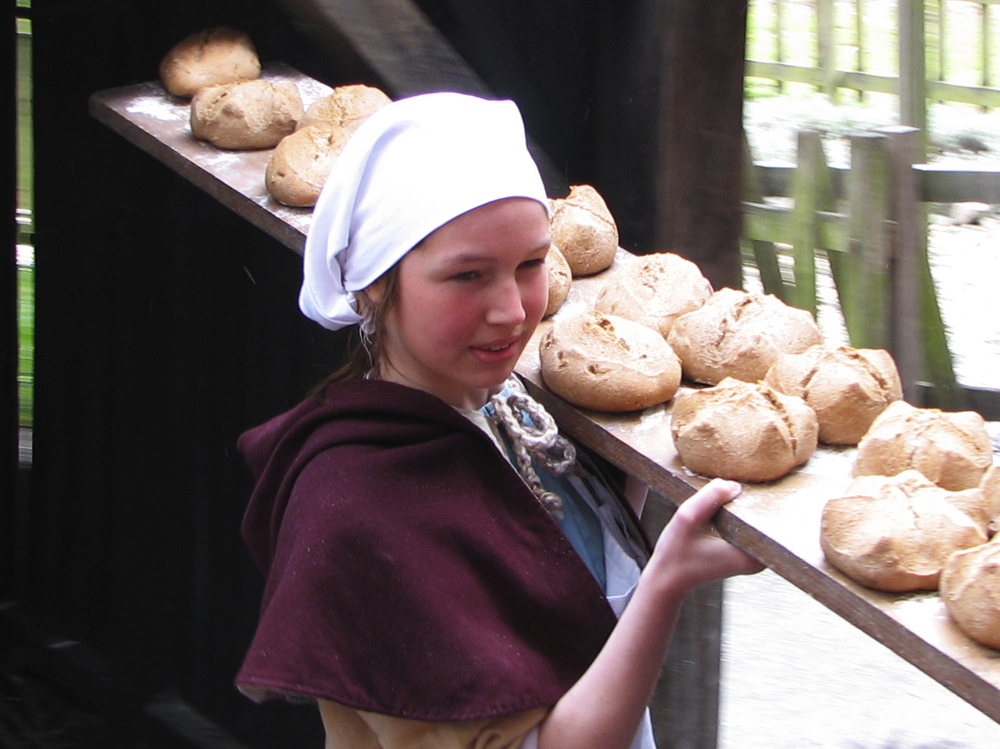There is no doubt that the tradition of giving alms in the form of bread or cookies on All Saints and All Souls has medieval roots.
The question, however, remains, which “soul cakes” were offered to the homeless and the hungry children?
One safe bet is that the most common gift was a bun, which might be cut in two, fried in butter on the open hearth and sprinkled with honey or even cinnamon, cardamom or ginger. At home such “French Toasts” – as we call them today – were often served with dried fruits, compotes and sour cream.
Poor Knights
The earliest known reference to French toast is in the Apicius, a collection of Latin recipes dating to the 4th or 5th century; the recipe mentions soaking in milk, but not eggs and gives it no special name, just Aliter Dulcia – “another sweet dish”. The recipe goes like this: “Break grated Sigilines (a kind of wheat bread), and make larger bites. Soak in milk, fry in oil, douse in honey and serve.”
Such a concoction can also be found in a 14th-century German recipe under the name “Arme Ritter” (German for “poor knights”). Not very specific, it states that the way to proceed is to “snitten armeritlere vnd backe die in smaltze niht zvo truege “ (Buoch von guter Spyse). Here it is mentioned as part of a kind of fried omelet.
In the 15th century the dish is mentioned more often. But it is obviously a dish, which was made according to what was in the pantry at any given time – the only two basic ingredients being stale bread and butter or other fat for frying. If available it made sense to soak the bread in milk and dip it in eggs, as well as serve it with anything available from honey, sweet fruity syrups and spices galore. Sometimes it was even made with wine instead of milk and was called “Betrunkene Jungfrau” – “Drunken Virgin”. Another and more refined version was the “Farced Wastells (see recipe in box)
Whatever the actual concoction, this simple dish was known all over Medieval Europe and went under a series of different names: Lost Bread – Arme Ritter – Poor Knight’s of Windsor – Nun’s Toast – Golden Slices of Bread (Pain Perdue – Arme Ritter – Fatias Douradas – Tostees Dorees)…
Twice cooked
Another way of eating stale bread was to make it even staler – thus cooking it twice – biscoctus, as the bread was called in Medieval Latin. Such biscuits were made out of any dough, which was a leftover from bread-baking. In peasant societies these often ended up as small buns, given to children as delicacies on baking-days. However, after baking they might also be dried out on an oven (or in an open hearth) until they hardened into a type of rusk.
Today we know the word primarily from the name of an Italian delicatessen – Biscotti de Prado. Or we recognise it as the root of biscuits. In Danish, we get closer to the original sense with the rough “Beskøjter”, which was a kind of dried-out bread, kept on ships to feed the sailors. Such bread was formed like small buns out of ordinary rough sourdough. After having been baked, they were dried in the oven before being loaded onboard. Crispy if not mouldy, they were dipped into the usual soup and thus softened up.
However, at some time it was discovered that such “Biscotti” might be improved by being baked out of a dough essentially supplemented by eggs, butter (or other shortening) and mixed with dried fruits and nuts. Such cakes might be more or less frugal, the luxurious edition made with a mixture of flour, butter and honey, thus turning it into short-bread; the poor version being more like a old crusty tea-bun.
In England these cookies were called Shortbread, while in Italy they kept their original name: Biscotti. Not until the later Middle Ages sugar was an option, but shortbread might very well be baked with honey as sweetener (see recipe)
Puddings
A final way of getting something for the sweet tooth was to bake a bread out of fine sifted flour and mixing the dough with gracious amounts of milk, cream and/or butter plus eggs. Added to this might be copious amounts of spices and dried fruits. Until baking soda was introduced, cooks of course had to rely on a mixture of sourdough, beer, buttermilk and eggs to get leavened and fluffy dough. According to the character of the mixture it might be either baked as bread, or poured into a bowl and cooked as a pudding.
Such bread might of course be baked as what we nowadays call tea-buns – which left to dry, could be halved and fried in butter; and thus end up as “Poor Knights”!
Or the dough could be poured directly into a pan as baked as a “pan-cake”. A thick medieval like pan-cake may (by the way) be made, by substituting fresh milk with half buttermilk and half beer. Let it stand around for a while and it will start to rise. The result will not be as thick as the “Aunt Jemima” variety; but good enough for a medievalist used to crepes.
RECIPES:
Farced Wastels ca. 1350
Farced Wastells are like rolls stuffed with French toast. Use rolls with a hard crust to help them hold together during boiling and not the bland, frozen variety.
6 large dinner rolls
2 eggs, beaten
4 tbsp. butter, melted
1/4 cup currants (zante)
1 tsp. powder fort – a mixture of e.g. grounded ginger (9), cinnamon (4,5), cloves (1), cubeb (1) grains of paradise (1) and pepper (1). The figures indicates the proportion between the spices.
1/4 tsp. salt
Pinch of saffron
Grind saffron, mix with butter and set aside. Cut centers out of rolls to make a little bowl, reserving removed breadcrumbs. Mix eggs, currants, butter mixture, powder fort, and salt. Pour over breadcrumbs (which preferably has been dried out first) and stir carefully until all bread is evenly coated. Stuff rolls with mixture. Put about an inch of water in the bottom of a large pan and bring it to boil. Then put in the rolls, reduce heat, and simmer for 15 minutes with the pan tightly covered. Remove immediately from water with a slotted spoon and serve hot.
Source: Curye on Inglish. Middle English recipes
Constance B. Hieatt (ed.), Sharon Butler (ed.)
Oxford University Press. Early English Text Society 1985
Biscotta – or Shortbread with Honey
Rub 225g butter into 425g plain flour.
Stir in 100g thick honey.
Make dough and knead until firm.
Roll out to 5-10mm thick, Cut into shapes, slice or leave whole as you prefer.
Bake at 180 degrees C for 10-15 min. until light and golden.
Graciously provided by Catherine Hanley – www.catherinehanley.co.uk
Poor Knights used in an omelette (c. 1350) – A Good Food
One should fry a hen, wrapped in speck. Then cut eight pieces of “Poor Knights” and fry them in fat, but not very dry. The peel and core apples, cut them in pieces and fry the in fat. The make a large omelet of eggs and add spices. Place a layer of apples, afterwords the “poor knights”, then the hen, which is cut into small pieces. Then make a sauce of spices, honey and wine – not to hot – and pour over the omelet, which has been doubled over and has had a window cut in the top. This is called “Hens from Greece” ( = Byzantium).
Source: Recipe no. 54 in Das Bouch von Guter Spise, from the Würzburg-Münchener Handschrift (1350), or nr. 51 from an edition from 1844 of another manuscript.
Daz buoch von guoter spise (The Book of Good Food). A Study, Edition, and English Translation of the Oldest German Cookbook.
By Melitta Weiss Adamson
Krems 2000 (Medium Aevum Quotidianum, Sonderband IX).
(A list of other editions of this book may be found here:
www.dasmittelalterkochbuch.de)
 In need of some music, while baking:
In need of some music, while baking:
A Soul, A Soul…
Soul, soul, a soul cake!
I pray thee, good missus, a soul cake!
One for Peter, two for Paul,
Three for Him what made us all!
Soul cake, soul cake, please good missus, a soul cake.An apple, a pear, a plum, or a cherry, any good thing to make us all merry.
One for Peter, two for Paul, and three for Him who made us all.
The old Soul-ballad is found in many variations (none of which goes back to the Middle Ages. ) Corresponding ones may be found in German and other European contexts. In a modern context the Soul-song is best known from the revival instigated by the Americal Folk Group peter, Paul and May in 1963. In 2009, this was once more taken up by the British rock musician Sting’s on his album: If on a Winter’s Night…
